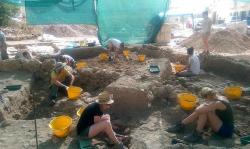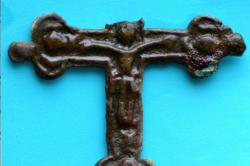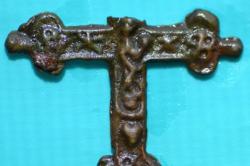INSTITUT SUPERIEUR D'ANTHROPOLOGIE
INSTITUTE OF ANTHROPOLOGY
ONLINE COURSES / COURS A DISTANCE
SUMMER TERM : JULY 2014
REGISTER NOW
MALTE –  Tac-Cawla - Dr Caroline Malone, Principal Investigator, from Queens University, Belfast along with a team of archaeologists has been working on the excavation of a rare settlement site at Tac-Cawla, which was first investigated in 1994 and 1995. Work started on the site at the end of March, and Dr Malone has said that they expect to close the site down early next week. The Gozo project was started in 1987 to investigate unsolved problems of the fourth and third millennium BC in Malta, the phase of temple construction. These problems were defined as: the reconstruction of funerary ritual (investigated through excavation at the Brochtorff Circle): the understanding of settlement organisation (investigated through regional field survey and limited excavation) and: the investigation of environmental change (investigated through the study of environmental indicators such as molluscs). This archaeological project brings together a range of different disciplines to solve an ancient puzzle, one that questions our notions of the “rise and fall of civilisation.” The project explores how humans in often very restricted places, such as islands, manage to survive and indeed, develop over long periods of time. Human history is punctuated by a succession of changing cultures and distinctive civilisations, each of which emerged specific to a time and place. The small island archipelago of Malta, one of Europe’s earliest civilisations, as the island laboratory for the investigation of a long-held question of cultural continuity and change in the Neolithic five and half thousand years ago. The archaeo-environmental project examines the development of this small island archipelago in order to develop models of how societies emerged, expanded, were sustained, and then finally declined, collapsed, or got transformed or replaced. Settled c.5300BC, and probably cleared of most of their pristine vegetation within a few centuries, the Maltese islands supported a thriving, substantially populated and remarkably sophisticated civilisation. By c.3000 BC, many extraordinary megalithic temples demonstrated the most precocious complex architecture and culture of the period in all Europe. For 2500 years, this relatively isolated island society maintained a high culture, and their temples appear to have been central to a well organised system of production and redistribution of foods and feasting.
Tac-Cawla - Dr Caroline Malone, Principal Investigator, from Queens University, Belfast along with a team of archaeologists has been working on the excavation of a rare settlement site at Tac-Cawla, which was first investigated in 1994 and 1995. Work started on the site at the end of March, and Dr Malone has said that they expect to close the site down early next week. The Gozo project was started in 1987 to investigate unsolved problems of the fourth and third millennium BC in Malta, the phase of temple construction. These problems were defined as: the reconstruction of funerary ritual (investigated through excavation at the Brochtorff Circle): the understanding of settlement organisation (investigated through regional field survey and limited excavation) and: the investigation of environmental change (investigated through the study of environmental indicators such as molluscs). This archaeological project brings together a range of different disciplines to solve an ancient puzzle, one that questions our notions of the “rise and fall of civilisation.” The project explores how humans in often very restricted places, such as islands, manage to survive and indeed, develop over long periods of time. Human history is punctuated by a succession of changing cultures and distinctive civilisations, each of which emerged specific to a time and place. The small island archipelago of Malta, one of Europe’s earliest civilisations, as the island laboratory for the investigation of a long-held question of cultural continuity and change in the Neolithic five and half thousand years ago. The archaeo-environmental project examines the development of this small island archipelago in order to develop models of how societies emerged, expanded, were sustained, and then finally declined, collapsed, or got transformed or replaced. Settled c.5300BC, and probably cleared of most of their pristine vegetation within a few centuries, the Maltese islands supported a thriving, substantially populated and remarkably sophisticated civilisation. By c.3000 BC, many extraordinary megalithic temples demonstrated the most precocious complex architecture and culture of the period in all Europe. For 2500 years, this relatively isolated island society maintained a high culture, and their temples appear to have been central to a well organised system of production and redistribution of foods and feasting.
http://gozonews.com/51212/tac-cawla-excavation-site-open-to-the-public-on-friday-saturday/
USA –  Canaveral National Seashore - A team of archaeologists unveiled plans Thursday morning to embark on an oceangoing expedition to find the lost French fleet of Jean Ribault, which sank 449 years ago in a hurricane off Florida’s Atlantic coast. And they have a pretty good idea where to look: Artifacts from the camps of survivors near the Canaveral National Seashore provide valuable clues. Ribault led a fleet of seven ships to the New World in 1565 to support the new Huguenot French colony of Fort Caroline, believed to be in what’s now Jacksonville. That colony alarmed and angered the Spanish, who quickly founded St. Augustine just down the coast to prepare for an attack on the French. The French, though, made a preemptive attempt to defeat the Spanish as Ribault sailed his four largest ships south. His plan turned disastrous as a hurricane scattered and wrecked his fleet. That left Fort Caroline vulnerable to an overland attack by the Spanish, who wiped out the colony. Meanwhile, Ribault and other shipwreck survivors trekked north back along the beach toward Fort Caroline, only to get stuck at the inlet later known as Matanzas — Spanish for “slaughter.” The Spanish, led by Pedro Menendez de Aviles, twice marched from St. Augustine to wipe out separate groups of survivors, more than 200 men in all, including Ribault himself. The location of the doomed ships has been a mystery since.
Canaveral National Seashore - A team of archaeologists unveiled plans Thursday morning to embark on an oceangoing expedition to find the lost French fleet of Jean Ribault, which sank 449 years ago in a hurricane off Florida’s Atlantic coast. And they have a pretty good idea where to look: Artifacts from the camps of survivors near the Canaveral National Seashore provide valuable clues. Ribault led a fleet of seven ships to the New World in 1565 to support the new Huguenot French colony of Fort Caroline, believed to be in what’s now Jacksonville. That colony alarmed and angered the Spanish, who quickly founded St. Augustine just down the coast to prepare for an attack on the French. The French, though, made a preemptive attempt to defeat the Spanish as Ribault sailed his four largest ships south. His plan turned disastrous as a hurricane scattered and wrecked his fleet. That left Fort Caroline vulnerable to an overland attack by the Spanish, who wiped out the colony. Meanwhile, Ribault and other shipwreck survivors trekked north back along the beach toward Fort Caroline, only to get stuck at the inlet later known as Matanzas — Spanish for “slaughter.” The Spanish, led by Pedro Menendez de Aviles, twice marched from St. Augustine to wipe out separate groups of survivors, more than 200 men in all, including Ribault himself. The location of the doomed ships has been a mystery since.
http://members.jacksonville.com/news/metro/2014-07-10/story/archeologists-mount-search-lost-french-fleet-1565?utm_
NORVEGE –  Stokke - Archaeologists have found what could be an 8,000 year old human skull in Stokke in Vestfold. The finding could help explain how it was to live in the Stone Age.For the past two months archaeologists have been digging at the Stokke site, believed to be two separate Stone Age settlements. The human skull containing brain matter is among many findings unearthed at the dig. It is hoped the skull can tell something about how it was to be a Stone Age human in Norway. It is not yet known whether the skull belongs to an animal or a child. Gaute Reitan, dig site leader, said to NRK: "It is too early to say. We need help from bone experts." Early tests date the skull to around 5,900 BC, showing it is almost 8,000 years old. Reitan said: "When we dug out some sample squares here, we very early came down to masses of soil, rich in carbon. We sent samples of this soil for fast dating in order to find a little more out of what we were dealing with. The bones in the pit are just as old."
Stokke - Archaeologists have found what could be an 8,000 year old human skull in Stokke in Vestfold. The finding could help explain how it was to live in the Stone Age.For the past two months archaeologists have been digging at the Stokke site, believed to be two separate Stone Age settlements. The human skull containing brain matter is among many findings unearthed at the dig. It is hoped the skull can tell something about how it was to be a Stone Age human in Norway. It is not yet known whether the skull belongs to an animal or a child. Gaute Reitan, dig site leader, said to NRK: "It is too early to say. We need help from bone experts." Early tests date the skull to around 5,900 BC, showing it is almost 8,000 years old. Reitan said: "When we dug out some sample squares here, we very early came down to masses of soil, rich in carbon. We sent samples of this soil for fast dating in order to find a little more out of what we were dealing with. The bones in the pit are just as old."
http://www.thelocal.no/20140710/archeologists-find-8000-year-old-skull-in-norway?
USA – 
 Avalon - Archaeologists at the Colony of Avalon site in Ferryland have unearthed an artifact that they say dates to the time of George Calvert’s dream of religious freedom in British North America.The Colony of Avalon Foundation said in a news release the rare finding is a small copper crucifix, 2.8 cm in width, broken at the top but showing a simple representation of Christ on the front and the Virgin Mary and Christ Child on the back.The Colony of Avalon said the crucifix was among a collection of ceramics, bones, nails and building debris associated with the construction of a large stone house built for Sir George Calvert, the first Lord Baltimore, in Ferryland. The construction of the home started sometime after 1623 and was completed before the arrival of Calvert, most of his family and about 40 additional settlers in 1628. The crucifix was once owned by a Catholic colonist at Avalon and served as a personal devotional item or as part of a rosary. The news release says in England, Catholics would be fined, imprisoned, or executed for openly practicing their religious beliefs, but George Calvert had a different vision for his New World colony at Ferryland. It was to be a place where all Christians would enjoy freedom of religion without fear of persecution. These forward-thinking ideas made Calvert’s Newfoundland colony the birthplace of religious toleration in British North America. The crucifix might have belonged to one of the craftsmen working on Calvert’s house, or the colony’s second governor, the Catholic gentleman Sir Arthur Aston, or even George Calvert himself.
Avalon - Archaeologists at the Colony of Avalon site in Ferryland have unearthed an artifact that they say dates to the time of George Calvert’s dream of religious freedom in British North America.The Colony of Avalon Foundation said in a news release the rare finding is a small copper crucifix, 2.8 cm in width, broken at the top but showing a simple representation of Christ on the front and the Virgin Mary and Christ Child on the back.The Colony of Avalon said the crucifix was among a collection of ceramics, bones, nails and building debris associated with the construction of a large stone house built for Sir George Calvert, the first Lord Baltimore, in Ferryland. The construction of the home started sometime after 1623 and was completed before the arrival of Calvert, most of his family and about 40 additional settlers in 1628. The crucifix was once owned by a Catholic colonist at Avalon and served as a personal devotional item or as part of a rosary. The news release says in England, Catholics would be fined, imprisoned, or executed for openly practicing their religious beliefs, but George Calvert had a different vision for his New World colony at Ferryland. It was to be a place where all Christians would enjoy freedom of religion without fear of persecution. These forward-thinking ideas made Calvert’s Newfoundland colony the birthplace of religious toleration in British North America. The crucifix might have belonged to one of the craftsmen working on Calvert’s house, or the colony’s second governor, the Catholic gentleman Sir Arthur Aston, or even George Calvert himself.
http://www.thetelegram.com/News/Local/2014-07-10/article-3794329/17th-century-crucifix-unearthed-in-Ferryland/1
POLOGNE – Gdańsk - Polish archaeologists have recovered one of the world’s oldest intact bottles of mineral water from a shipwreck lying on the bottom of the Baltic Sea. Still corked, the perfectly preserved stoneware bottle was produced between 1806 and 1830 by Selters, one of the oldest mineral waters in Europe. The 12-inch bottle was found during archaeological work on a shipwreck lying at a depth of about 40 feet in the Gdańsk Bay not far from the Polish coast. Little is known about the wreck. Archaeologists called it F-33-31 or “Głazik,” meaning boulders in Polish. Indeed, its cargo of large stones suggests the vessel was probably used for transporting construction materials along the Baltic coast. So far, the stoneware bottle is the most valuable find retrieved from the wreck.
http://news.discovery.com/history/archaeology/200-year-old-bottle-of-mineral-water-found-in-shipwreck-140710.htm